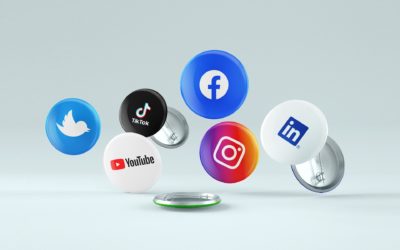In recent months, the consumption of digital media has once again skyrocketed, and organizations are forced to take this trend into account within the scope of their own marketing. As part of their own advertising activities, they are increasingly relying on influencers who represent the brand on social networks or present specific products and/or services to their own audience. As a consumer, you are now inundated with advertising and other sponsored content on the corresponding platforms. This raises the question of whether influencer marketing will continue to be a successful advertising tool or whether the immense volume will limit its effectiveness in the medium term. This post will look at why influencer marketing has been a highly effective marketing tool to date, how organizations can best integrate influencers into their own advertising activities, and whether the continuously increasing number of influencers is limiting the effectiveness of influencer marketing.
Disclaimer
All content and statements within the blog posts are researched to the best of our knowledge and belief and, if possible, presented in an unbiased manner. If sources are used, they are indicated. Nevertheless, we explicitly point out that the content should not be understood as facts, but only as a suggestion and thought-provoking ideas for the own research of the readers. We assume no liability for the accuracy and/or completeness of the content presented.
Consumption of media is increasingly taking place digitally, with little difference between informative and entertaining media. In this digital environment, new opportunities are also opening up for organizations to promote their own brand or specific products and/or services. Influencers, who (can) use their already existing reach for advertising purposes, are being used more and more frequently. For this, they are compensated accordingly by the organizations. However, the compensation does not have to be money, but can also be in the form of non-cash assets, vouchers, discount codes, etc. The latter is especially the case when influencers promote explicit products.¹
Even though influencer marketing is sometimes associated with considerable costs due to the prices charged by individuals, it is still an effective and efficient form of advertising. This is essentially because influencers usually not only sell their own reach to various organizations but are also involved in creating content and interacting with consumers. If the influencers that organizations collaborate with are strategically selected, organizations can target a specific audience through collaboration, as most influencers reach specific people or groups of people based on their published content and acquire corresponding followers. The focus on specific industries or niches also means that influencers are increasingly seen as “experts” and recommendations therefore appear more credible. This can have a positive impact on consumers’ potential purchase intent. Perhaps the most important factor in favor of influencer marketing, however, is the fact that many influencers act as a kind of social media manager for organizations. Not only do they provide their reach, but they also provide valuable insights, create relevant content, can make strategic recommendations, and manage their respective communities by interacting with their followers on a regular basis. Thus, when deciding whether to use influencers for promotional purposes, organizations should always keep the total package in mind.²
Perhaps the most effective form of advertising is still word-of-mouth among friends and acquaintances, but this is also becoming increasingly digital (electronic word-of-mouth or eWOM).³ Influencers are perceived as much closer than classic celebrities, and many people can better compare or identify with them. The proximity to one’s own person can increase the influenceability, so that advertising through influencers is often perceived better than when celebrities appear as brand ambassadors or advertising figures. Social media users also see influencers – albeit in a limited way – as (equal) users and the reduced distance as well as a personal connection to influencers leads to more trust in the respective person.⁴ The ultimate goal of most advertising activities is to ultimately sell a product or service. However, before people buy something, there must first be an intention to buy. Lou & Yuan (2019) have shown in their work that a purchase intention in response to influencer marketing is particularly present when influencers share informative posts with their followers and the information provided also has value for the addressees.⁵
It can be assumed that on all platforms with a sufficiently large audience, there will continue to be opinion leaders and other individuals who exploit their reach to steer the perception of other users. As long as this is the case, there will also be an incentive for organizations to cooperate with the relevant individuals and use their influence for their own benefit. Organic growth on various platforms is also difficult for already well-known organizations, so influencers could also be used here to reach a new audience for the first time and subsequently bind the corresponding individuals to one’s own brand. In this context, it is conceivable that organizations not only benefit from the reach of influencers but are also subject to risks due to their close association with personal brands. Misconduct and other scandals can quickly cast high-profile individuals in a bad light, which in turn could rub off on the perception of the organizations partnering with the individual. In addition, organizations relinquish some of their own control in the context of influencer marketing, so that previously clearly communicated core messages could become less clear or the influencers could be too much in the foreground.
It’s also possible that the way influencers and organizations work together will change in the future. The mass of influencers trying to gain followers on social networks and monetize their own personal brand makes it increasingly difficult for individuals to stand out. If marketing one’s own reach becomes increasingly difficult, this may lead influencers to look for alternative offerings. One conceivable approach would be for them to become more closely involved in the marketing structures of organizations. Many organizations struggle to reach young people and get them excited about their own products and/or services. A large proportion of influencers solve this challenge on a daily basis, so a transfer of expertise here might be a sensible solution for everyone involved. In such a scenario, influencers would be seen more as content creators and could monetize their skills in this way. However, young adults in particular are increasingly striving for independence, and this also has an impact on their career paths. In order to maintain the high degree of independence, influencers could act as freelancers – if necessary, also together with their existing team – and thus contribute to the day-to-day marketing activities of large corporations.
For many organizations, influencer marketing is a central component of their own digital activities. Users of the various social networks feel more connected to influencers than to classic celebrities and can identify with them more easily. The closeness to consumers that results from regular interaction with one’s own followers and the feeling of expertise mean that recommendations from influencers are perceived as more credible and can encourage purchase intentions. However, the continuously growing number of influencers makes it increasingly difficult to stand out from the crowd, become known, and monetize one’s own reach. One plausible scenario is that influencers will increasingly be integrated into the marketing structures of organizations and, with the help of their own skills, help their clients to address and retain a young audience. Influencers could thus provide strategic support as a kind of freelancer, create content or maintain existing online communities.
¹ Dimitrieska, S., & Efremova, T. (2021). The Effectiveness of the Influencer Marketing. Economics and Management, 18(1), 109-118.
https://doi.org/10.37708/em.swu.v18i1.9.
² Campbell, C., & Farrell, J. R. (2020). More than meets the eye: The functional components underlying influencer marketing. Business Horizons, 63(4), 469-479.
https://doi.org/10.1016/j.bushor.2020.03.003.
³ Sokolova, K., & Kefi, H. (2020). Instagram and YouTube bloggers promote it, why should I buy? How credibility and parasocial interaction influence purchase intentions. Journal of Retailing and Consumer Services, 53, 1-16.
https://doi.org/10.1016/j.jretconser.2019.01.011.
⁴ Jin, S. V., Muqaddam, A., & Ryu, E. (2019). Instafamous and social media influencer marketing. Marketing Intelligence & Planning.
https://doi.org/10.1108/MIP-09-2018-0375.
⁵ Lou, C., & Yuan, S. (2019). Influencer marketing: how message value and credibility affect consumer trust of branded content on social media. Journal of Interactive Advertising, 19(1), 58-73.
https://doi.org/10.1080/15252019.2018.1533501.



